Making sense of wildfire jargon
The U.S. Forest Service has compiled a handy list of definitions to some of the lingo and terminology used by wildland firefighters.
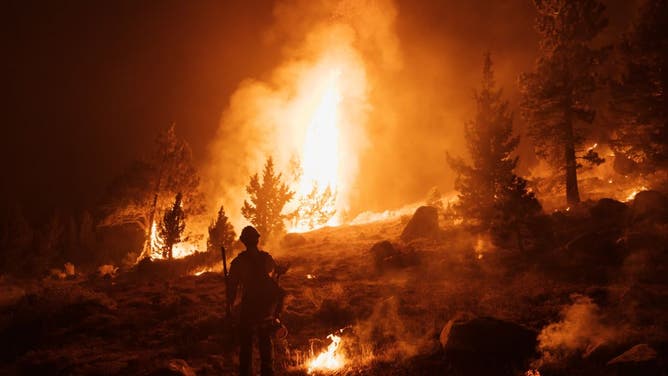
Firefighters perform a controlled burn as a preventative measure during the Caldor Fire in Kirkwood, California, U.S., on Thursday, Sept. 2, 2021.
(Eric Thayer/Bloomberg / Getty Images)
Wildfires are a regular part of the summer season, and with their extensive news coverage and press conferences from fire officials, you may run across several terms you may not be familiar with.
Luckily, the U.S. Forest Service has compiled a handy list of definitions to some of the jargon and terminology used by wildland firefighters.
=====
Aerial Fuels:
All live and dead vegetation in the forest canopy or above surface fuels, including tree branches, twigs and cones, snags, moss, and high brush.
Anchor Point:
An advantageous location, usually a barrier to fire spread, from which to start building a fire line. An anchor point is used to reduce the chance of firefighters being flanked by fire.
Aspect:
The direction toward which a slope faces.
Bambi Bucket:
A collapsible bucket slung below a helicopter. Used to dip water from a variety of sources for fire suppression.

A Type 1 Helicopter supports wildland firefighters during the Pillar Falls Fire in Idaho.
Blow-up:
A sudden increase in fire intensity or rate of spread is strong enough to prevent direct control or to upset control plans. Blow-ups are often accompanied by violent convection and may have other characteristics of a firestorm.
Bucket Drops:
The dropping of fire retardants or suppressants from specially designed buckets slung below a helicopter.
Buffer Zones:
An area of reduced vegetation that separates wildlands from vulnerable residential or business developments. This barrier is similar to a greenbelt in that it is usually used for other purposes such as agriculture, recreation areas, parks, or golf courses.
Candle or Candling:
A single tree or a tiny clump of trees that is burning from the bottom up.
Chain:
A unit of linear measurement equal to 66 feet.
Cold Trailing:
A method of controlling a partly dead fire edge by carefully inspecting and feeling with the hand for heat to detect any fire, digging out every live spot, and trenching any live edge.
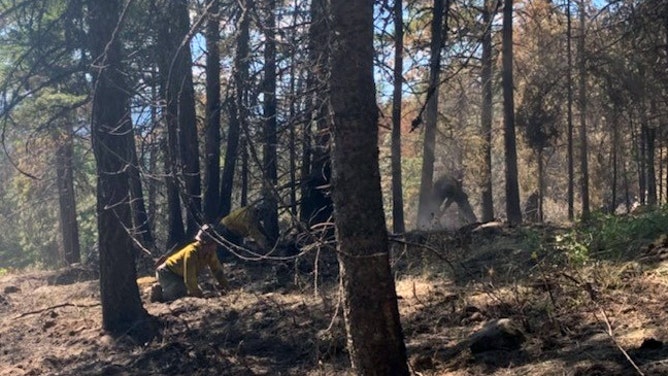
Cold trailing on the Leland Complex.
(Idaho Department of Lands)
Complex:
Two or more individual incidents located in the same general area that are assigned to a single incident commander or unified command.
Coyote Tactics:
A progressive line construction duty involving self-sufficient crews that build fire lines until the end of the operational period, remain at or near the point while off duty and begin building fire lines again the next operating period where they left off.
Crown Fire (Crowning):
The movement of fire through the crowns of trees or shrubs is more or less independent of the surface fire.
Dozer Line:
A fire line constructed by the front blade of a dozer.
Drip Torch:
Hand-held device for igniting fires by dripping flaming liquid fuel on the materials to be burned; consists of a fuel fount, burner arm, and igniter. Fuel used is generally a mixture of diesel and gasoline.
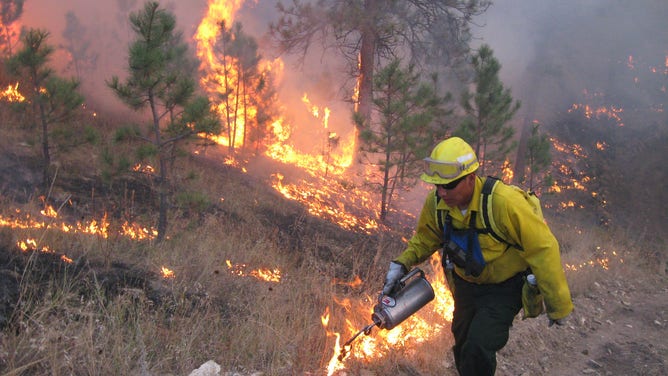
Bureau of Indian Affairs firefighter is conducting burnout operations with a drip torch.
(National Interagency Fire Center)
Entrapment:
A situation where personnel is unexpectedly caught in a fire behavior-related, life-threatening position where planned escape routes or safety zones are absent, inadequate, or compromised. An entrapment may or may not include the deployment of a fire shelter for its intended purpose. These situations may or may not result in injury. They include "near misses."
Extreme Fire Behavior:
"Extreme" implies a level of fire behavior characteristics that ordinarily precludes methods of direct control action. One or more of the following is usually involved: high rate of spread, prolific crowning and/or spotting, presence of fire whirls, strong convection column. Predictability is difficult because such fires often exercise some degree of influence on their environment and behave erratically, sometimes dangerously.
Faller:
A person who fells trees. Also called a sawyer or cutter.
Fingers of a Fire:
The long narrow extensions of a fire projecting from the main body.
Fire Break:
A natural or constructed barrier used to stop or check fires that may occur or to provide a control line from which to work.
Fire Front:
The part of a fire within which continuous flaming combustion is taking place. Unless otherwise specified, the fire front is assumed to be the leading edge of the fire perimeter. In-ground fires, the fire front may be mainly smoldering combustion.
Fire Storm:
Violent convection caused by a large continuous area of intense fire. Often characterized by destructively violent surface indrafts, near and beyond the perimeter, and sometimes by tornado-like whirls.
Fire Whirl:
Spinning vortex column of ascending hot air and gases rising from a fire and carrying aloft smoke, debris, and flame. Fire whirls range in size from less than one foot to more than 500 feet in diameter. Large fire whirls have the intensity of a small tornado.
Flanks of a Fire:
The parts of a fire's perimeter that are roughly parallel to the main direction of spread.
Flare-up:
Any sudden acceleration of fire spread or intensification of a fire. Unlike a blow-up, a flare-up lasts a relatively short time and does not radically change control plans.
Head of a Fire:
The side of the fire having the fastest rate of spread.
Heavy Fuels:
Fuels of a large diameter, such as snags, logs, large limb wood, that ignite and are consumed more slowly than flash fuels.
Hotshot Crew:
A highly trained fire crew used mainly to build firelines by hand.
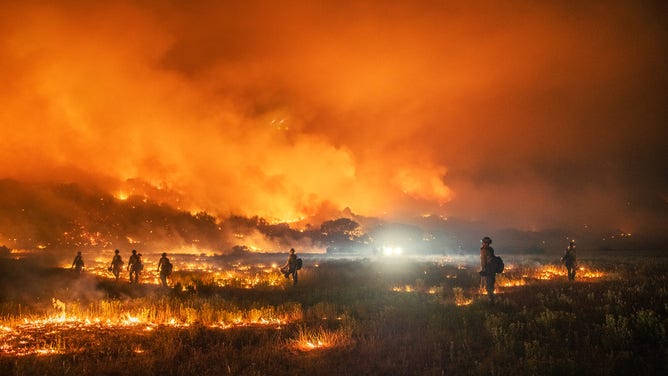
Night operations on the Pine Gulch Fire in Colorado.
(Kyle Miller, Wyoming Hotshots, USFS)
Ladder Fuels:
Fuels that provide vertical continuity between strata, thereby allowing the fire to carry from surface fuels into the crowns of trees or shrubs with relative ease. They help initiate and assure the continuation of crowning.
Line Scout:
A firefighter who determines the location of a fire line.
Mop-up:
To make a fire safe or reduce residual smoke after the fire has been controlled by extinguishing or removing burning material along or near the control line, felling snags, or moving logs so they won't roll downhill.
Prescribed Fire:
Any fire ignited by management actions under certain, predetermined conditions to meet specific hazardous fuels or habitat improvement objectives. A written approved prescribed fire plan must exist, and NEPA requirements must be completed before ignition.
Pulaski:
A combination chopping and trenching tool, which combines a single-bitted ax-blade with a narrow adze-like trenching blade fitted to a straight handle. Useful for grubbing or trenching in duff and matted roots. Well-balanced for chopping.
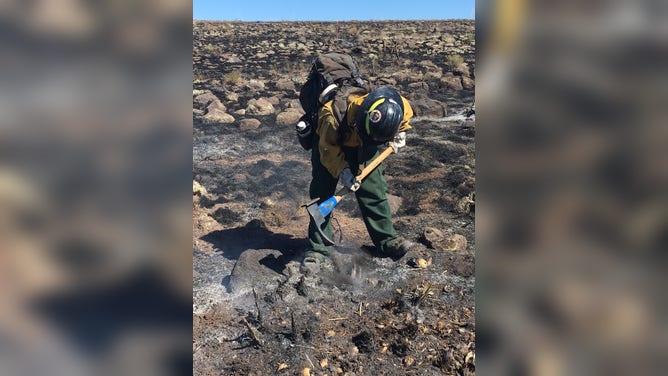
Bureau of Indian Affairs firefighter is digging a fireline with a Pulaski.
(National Interagency Fire Center)
Run (of a fire):
The rapid advance of the head of a fire with a marked change in fireline intensity and rate of spread from that noted before and after the advance.
Running:
A rapidly spreading surface fire with a well-defined head.
Scratch Line:
An unfinished preliminary fire line hastily established or built as an emergency measure to check the spread of fire.
Slop-over:
A fire edge that crosses a control line or natural barrier intended to contain the fire.
Smokejumper:
A firefighter who travels to fires by aircraft and parachute.
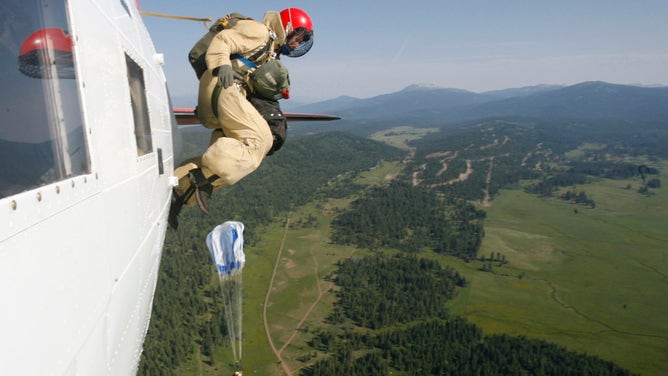
Smokejumper Larry Wilson exits a DC-3TP airplane during training jumps near McCall, Idaho, while preparing for the 2008 fire season.
(Darin Oswald/Idaho Statesman/Tribune News Service / Getty Images)
Snag:
A standing dead tree or part of a dead tree from which at least the smaller branches have fallen.
Swamper:
(1) A worker who assists fallers and/or sawyers by clearing away brush, limbs and small trees. Carries fuel, oil and tools and watches for dangerous situations. (2) A worker on a dozer crew who pulls winch line, helps maintain equipment, etc., to speed suppression work on a fire.
Terra Torch:
Device for throwing a stream of flaming liquid, used to facilitate rapid ignition during burn-out operations on a wildland fire or during a prescribed fire operation.
Wet Line:
A line of water, or water and chemical retardant, sprayed along the ground that serves as a temporary control line to ignite or stop a low-intensity fire.